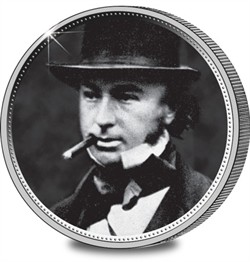
 |
Full name: Isambard Kingdom Brunel
Born: 9th April 1806
Place of Birth: Portsmouth
Occupation: Mechanical Engineer
Died: 15th September 1859
|
Isambard Kingdom Brunel was an innovative mechanical engineer
who built and designed a number of revolutionary
constructions. Born in Portsmouth on 9th April 1806, Isambard
Brunel was taught engineering by his father who was a French civil
engineer and by the age of eight, Brunel had grasped the basics of
engineering and progressed rapidly. Isambard attended school in
Hove, Brighton and at the age of 14, he went to study in Paris,
France before he began working for his father.
Isambard and his father planned the construction of the Thames
tunnel (from Rotherhithe to Wapping) and they eventually completed
it in 1843.
In 1829, Isambard entered and won a competition to design the
famous Clifton Suspension Bridge across the River Avon in Bristol,
which was planned to be the longest bridge in the world. Due
to a lack of funds, the bridge was not completed until 1864, after
Brunel's death. Brunel was appointed chief engineer at
Bristol Docks in 1831 and designed the Monkwearmouth Docks before
completing one of his greatest works, the Great Western
Railway.
Brunel became chief engineer for the Great Western Railway and
designed and constructed the railway's main network of tunnels and
bridges that linked Bristol with London. Brunel constructed
the Maidenhead Bridge, Bristol Temple Meads Station, the Box Tunnel
and various viaducts at Hanwell and Chippenham.
Brunel allowed for faster and smoother journeys by using the
broad guage (2.2m) in place of the standard guage
(1.55m).
Brunel wanted to further revolutionise travel and persuaded the
Great Western company who funded the Great Western Railway to
invest in trans-atlantic travel for the first time in world
history. As a result, Brunel designed and built a steam ship
named the Great Western, which would allow crossings from Bristol
to New York and became the first steam ship to provide a
transatlantic service.
Each crossing took 15 days and a total of 60 crossings were
completed over a period of eight years until Brunel began devising
an improved version of the steam ship.
In 1843, the revolutionary SS Great Britain was launched, which
was the first screw propeller driven transatlantic steamship and
the largest ship in the world. SS Great Britain became the
inspiration and basis for the further development of modern
ships. The luxury passenger ship was designed for
international travel and was able to carry 252 passengers and 130
crew.
In 1853, Brunel was commissioned to build the Great Eastern,
which was the biggest ever ship to be built up to that time and was
able to carry 4,000 passengers. However, the ship encountered
various engineering problems and Brunel began to suffer ill-health
which lead to his death on 15th September 1859.